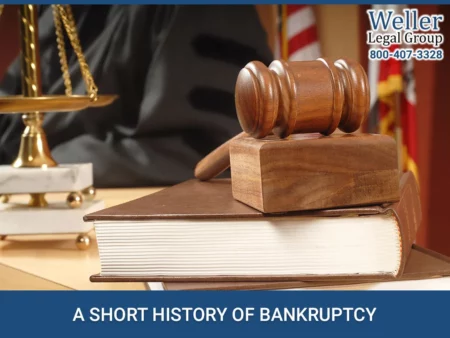 The etymology of the term “bankruptcy” is commonly believed to derive from a combination of two Latin words: “bancus” (table or bench) and “ruptus” (broken). The theory suggests that a public banker, upon failing to meet financial obligations, would have his bench—where transactions took place—broken as a symbol of his inability to negotiate and fiscal failure. This practice was widespread in Medieval Italy, leading many to attribute the term “bankrupt” to the Italian phrase “banco rotto,” translating to “broken bank.” Alternatively, some attribute the origin to the French phrase “banque route,” meaning “table trace,” which symbolizes a similar concept.
The etymology of the term “bankruptcy” is commonly believed to derive from a combination of two Latin words: “bancus” (table or bench) and “ruptus” (broken). The theory suggests that a public banker, upon failing to meet financial obligations, would have his bench—where transactions took place—broken as a symbol of his inability to negotiate and fiscal failure. This practice was widespread in Medieval Italy, leading many to attribute the term “bankrupt” to the Italian phrase “banco rotto,” translating to “broken bank.” Alternatively, some attribute the origin to the French phrase “banque route,” meaning “table trace,” which symbolizes a similar concept.
Early Federal Bankruptcy Laws
Early federal laws having to do with filing Chapter 7 or filing Chapter 13 bankruptcy in the US were merely band-aid solutions to unfavorable economic circumstances.
Early US federal laws having to do with filing Chapter 7 or filing Chapter 13 were only stopgap measures for a collapsing economy: The first official law regarding when someone would file bankruptcy was enacted in response to land speculation in 1800 and swiftly overturned in 1803. This law contained a clause that allowed for the cancellation of unpaid debts when you file bankruptcy. Only a small amount of debt could be discharged under the laws of 1800 and 1841, and the first law to provide corporate protection was the law of 1867.
Current Bankruptcy Laws Regarding How to File Bankruptcy
In the United States, current laws and procedures regarding filing Chapter 7 or filing Chapter 13 place more of an emphasis on assisting struggling debtors in getting back on their feet than on punishing them. New laws regarding filing Chapter 7 or filing Chapter 13 were created because of the Great Depression’s economic upheaval, most notably the Bankruptcy Acts of 1933 and 1934. In a 1934 ruling, the U.S. Supreme Court stated that the primary goal of bankruptcy laws was to give debtors a “fresh start” from their financial obligations. The Supreme Court argues in Loan v. Hunt in Local that bankruptcy gives the honest, unfortunate debtor a new opportunity in life and a clear field for future effort, unhindered by the discouragement and pressure of preexisting debt since they could file bankruptcy.
The Chandler Act
The legislation that started it led to the Chandler Act of 1938, which had significant provisions for corporate restructuring when a company would file bankruptcy. The legislation’s pinnacle was the Chandler Act of 1938, which had significant provisions for corporate restructuring. Additionally, the Bankruptcy Act’s Section 60e was passed by Congress in 1938. It introduced the concept of a single, distinct fund and was intended to lessen customer losses by giving priority to customer claims over those of general creditors. Significant turmoil in the securities market in 1969 and 1970 led to the voluntary closures, mergers, receiverships, and bankruptcies of a sizable number of brokerage firms. Congress responded by passing the Securities Investor Protection Act of 1970, plus dealers, to halt the filings, restore investor confidence, and tighten the requirements for registered brokers’ financial responsibility.
Getting Help Filing Chapter 7 or Filing Chapter 13 Bankruptcy
The Weller Legal Group, nestled in Tampa, FL, holds an esteemed reputation in the legal community for specializing in bankruptcy filing. Their rich tapestry of experience in facilitating Chapter 7 and Chapter 13 bankruptcy filings has enabled many individuals and businesses to traverse the intricacies of bankruptcy procedures. Whether you are in unmanageable debt or seek support in reorganizing your financial landscape, the Weller Legal Group is steadfastly dedicated to delivering bespoke and efficacious legal strategies that align perfectly with your unique needs.
Picture Credit: Shutterstock

